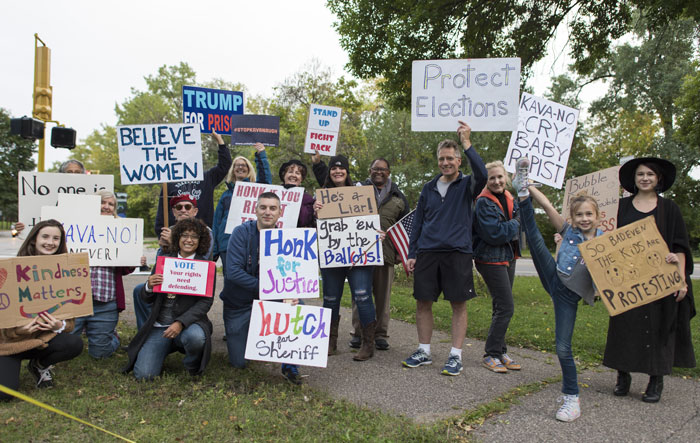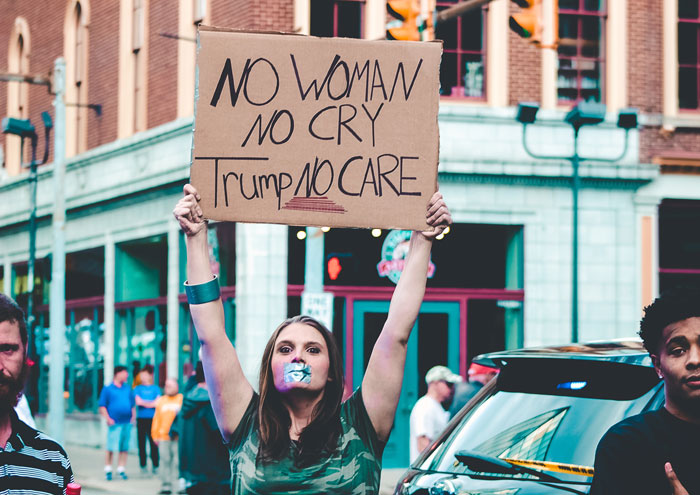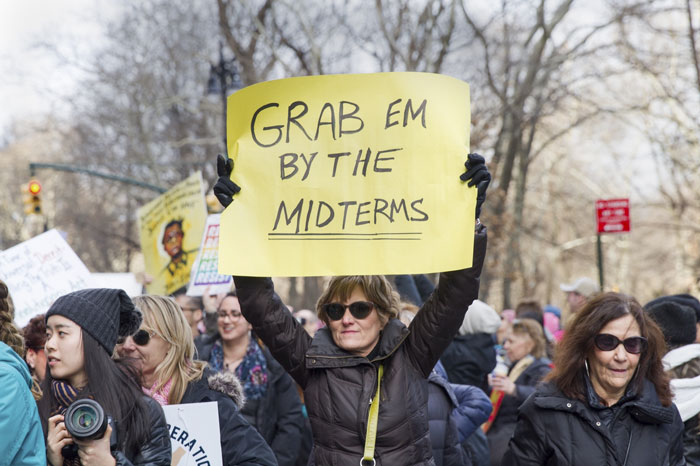A Wave of Hope and Renewal with the New Year |
|||||||||
| by Kate Mueller | |||||||||
Hopes were high in some quarters that Christine Hallquist, Democratic candidate for governor, would somehow buck precedent and beat an incumbent gubernatorial candidate, which hasn’t happened in Vermont since 1962. She was also seeking to buck the status quo: Vermont has had only one female governor in its 240-year history (the first dozen years as an independent republic), and Hallquist was on track to become the nation’s first transgender governor. Unsurprisingly, Hallquist lost, garnering 40 percent of the vote to Phil Scott’s 55 percent (the remaining votes were cast among the four third-party candidates). But these results are, arguably, still impressive, given the challenges she faced.
The good news was that most Vermonters were generally accepting of Hallquist and were more focused on the issues. And Vermont politicians went out of their way to conduct a civil race, avoiding ad hominem attacks, with Scott condemning the threats against Hallquist. “We must—as a society—do better to combat anger and violence,” he said during the campaign. “I’m hopeful Vermonters will join me in ensuring everyone—regardless of gender, race, ethnicity, sexual orientation, religion, or other characteristics—are treated with dignity, respect, and acceptance.” Two candidates running for an open seat in the Vermont House of Representatives in Lamoille County, Lucy Rogers (D) and Zac Mayo (R), even performed a duet together after a debate in a local library, with Rogers on cello and Mayo on guitar. The duet caught the attention of the national news, with a CBS reporter calling it a “landslide victory for civility.” In a national climate that has become increasingly divisive and harsh, this civility was a welcome relief.
Rogers won the seat and at age 23 will be one of the youngest members in the legislature. Her win was part of a Democratic sweep of the state legislature. Vermonters chose to keep a Republican as their governor, but they bolstered and solidified the Democratic majority in both legislative chambers. Rogers’s district was one of 12 that flipped to the Democrats. The Democrats also lost two seats, but with Progressives retaining their seven seats, their combined causcuses resulted in a net gain of 12, adding up to 102. The Democrats also gained seats in the Senate; that chamber now has 22 Democrats, two Progressives, and six Republicans. Vermont requires a a two-thirds vote from both legislative chambers to override the governor’s veto, which means 100 of the 150 members of the house and 20 of the 30 members of the senate. With 102 potential votes in the house and 24 in the senate, the Democrats have a solid veto-proof majority. Democrats and Progressives may now be able to pass legislation that the governor stymied during the last legislative session, such as raising the minimum wage, providing paid family leave, and instituting a carbon tax.
The big news is the shifts that happened in the US Congress and in gubernatorial and congressional races in other states. Voters elected the most diverse and most female group of freshman representatives in history. The influx of women into the US House of Representatives has surpassed that of the lauded 1992 Year of the Woman, when 24 women were elected to the House and three female senators joined the Senate, tripling the number of women in that chamber. Among those elected to the Senate at that time were Dianne Feinstein and Patty Murray, both still serving, and Carol Moseley Braun, the first African American woman to join the Senate. One factor often cited for the 1992 female influx was the controversial Anita Hill hearings and confirmation of Clarence Thomas to the US Supreme Court. One can’t help but draw some parallels to the recent confirmation of Brett Kavanaugh to the Court, which galvanized many women, concerned about the threat Kavanaugh poses to Roe v. Wade (though Trump remains galvanizer number one). Notably, many winning female congressional candidates ran campaigns emphasizing the need for better health care. This midterm, a record 35 women joined the House, all but one of them Democrats and most of them replacing men who previously held those seats. They are an inspiring and diverse lot and include many firsts. For the first time, the House will have two Muslim American congresswomen (Ilhan Omar of Minnesota and Rashida Tlaib of Michigan) and two Native American congresswomen (Deb Haaland of New Mexico and Sharice Davids of Kansas). For the first time, two Hispanic congresswomen will represent Texas, Veronica Escobar and Sylvia Garcia. Massachusetts will send its first black congresswoman to Washington, DC, (Ayanna Pressley), as will Connecticut (Jahana Hayes). In Florida, Debbie Mucarsel-Powell, an immigrant from Ecuador and an educator, won. Kim Schrier, a pedicatrician who ran on stronger gun regulations, won Washington’s eighth district. Pennsylvania, which currently has no women in the House, will have four starting in January, including Chrissy Houlahan, an air force veteran. The number of female incumbents reelected to the House has also jumped, compared to that earlier Year of the Woman, from 23 in 1992 to 66 in 2018. Most of the female incumbents in the House are Democrats (54 versus 12 Republicans). Come January 2019, a record 101 women will make up the House. For those despairing over the aging overly white and male cohort that makes up most of Congress, and the previous lack of any Democratic check on Trump and the Republican majority, this was a welcome turn of events. But from a strictly gender perspective, we still have a ways to go. Out of a total of 435 representatives, women still make up less than a quarter of the House, as they do in the Senate, with just 23 out of 100 senators female. Congress has yet to be a true representation of the population of the United States.
One disconcerting aspect to the recent midterms was the high percentage of white women voting for Republican candidates, according to exit polls. For one snapshot, consider this: a whopping 76 percent of white women voters cast their ballots for Brian Kemp, preferring him to the groundbreaking candidacy of Stacey Abrams, running for governor in Georgia. They helped keep Texas senator Ted Cruz in office: 59 percent of them voted for him instead of Beto O’Rourke. And 51 percent threw in their lot with Ron DeSantis for governor of Florida, instead of Andrew Gillum, who wants to ban assault weapons, versus DeSantis, who is opposed to gun control and supports Florida’s “stand your ground” statue (and this in the state of the Parkland shooting). Their African American sisters are far more progressive: by overwhelming percentages, they supported O’Rourke, Abrams, and Gillum. What’s going on here? A look at exit poll statistics might provide some clues (www.cnn.com/election/2018/exit-polls). Overall, white women were evenly split between the two parties, with 49 percent voting Democratic and 49 percent voting Republican (versus 59 percent of women overall voting Democratic). But broken down further, educated white women reflect the overall demographic, with 59 percent voting Democratic. The tilt factor seems, in part at least, to be non-college-educated white women, 56 percent of whom voted Republican. Furthermore, this group exceeds in numbers the college educated, making up 21 percent of the total electorate, versus 16 percent for college-educated white women (on average about 33 percent of the US population has at least a bachelor’s degree). Articles and even books have attempted to tackle the conundrum of the white woman vote. An article in the Guardian (Nov. 9, 2018) essentially concludes, as have some other articles I’ve read, that white women vote this way, seemingly against their interests, because they are racist. According to the author, they are caught in a crucible of oppression and privilege, granted power through race but excluded through their gender. Instead of rallying round and seeking rights for their gender, they throw their lot in with race, seeking to maintain the current white power structure, with white men at the helm. Race is a factor, but it may be more unconscious than overt, and economics may actually play a bigger role. Married women in general tend to vote for the same candidates as their husbands and to vote more conservatively, and this tendency is more evident among married white women, who want to maintain or increase their husbands’ earning power and status, and thus that of themselves and their children, according to a study published in April 2017 (“Gender Linked Fate/Ethnicity, and the Marriage Gap in American Politics”). So yes, they are maintaining the status quo, but not necessarily from some overt macro, white perspective; it’s more personal and narrowly pragmatic. Interestingly, when the word of a white woman (Christine Blasey Ford) was pitted against that of a white man (Brett Kavanaugh), less than half of white women voters in the United States believed Ford. A Quinnipiac University poll, released on October 1, revealed that 46 percent of white women believed her versus 55 percent of women, overall. Although the sexual assault allegations enraged many women (including white women), who considered Kavanaugh unfit to serve as a justice, other women, mostly white, were enraged on behalf of Kavanaugh—seeing him as the victim of political operatives and, perhaps, an unscrupulous woman. In a November 3, 2018, article, the New York Times interviewed white women who support Trump to get a sense of why. What came across in part was that they are genuinely afraid of immigrants and see Trump as a kind of hero or father figure, protecting them and their way of life—which includes, I think, protecting the male (and white) breadwinners in their lives from others, including other women, who challenge and threaten them. And so they defend Trump, who in this view is being unfairly criticized. The aforementioned Guardian article did hint at some light at the end of this curious dark tunnel by providing a historical perspective. The 53 percent of white women who voted for Trump in the 2016 election is down from the 56 percent who voted for Mitt Romney, which is a further slide from the 62 percent who voted for Ronald Reagan. Overall, white female support of Republicans during the 2018 midterms has slipped, to 49–50 percent.
|
|||||||||
|
Kate Mueller is the Editor of Vermont Woman
|
||||||||



